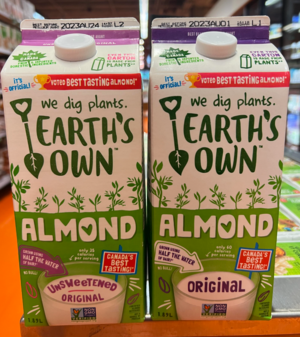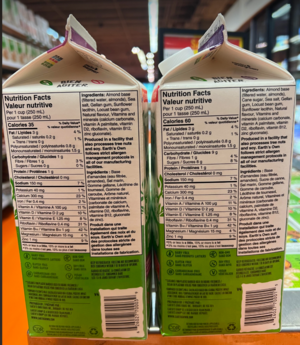Course:FNH200/Assignments/2023/Earth's Own Unsweetened vs Regular Almond Milk
Brief Introduction
Earth’s Own is a Canadian brand which promotes plant-based diet. This brand is specially popular among individuals who are shifting to more sustainable dairy-free products full of organic ingredients such as almond milk, oat milk, and soy milk. We will explore Earth's Own Almond Milk which has a creamy and rich almond taste, furthermore it is gluten-free, non-GMO and vegan. This dairy-free milk comes in different flavours such as vanilla, chocolate, and salted caramel and also there is an unsweetened version.[1]



Ingredient lists
| Earth's Own Original Almond Milk |
|---|
|
| Earth's Own Unsweetened Almond Milk |
|---|
|
Role of Substitutes & Additives
Fat Substitutes
There are no fat substitutes
Sugar Substitutes
Cane Sugar
Cane sugar is a sugar substitute for granulated sugar as it is minimally processed, it contributes to the flavour of almond milk by sweetening it.[2]
Additives
Gellan Gum
Gellan Gum is a water soluble, polysaccharide additive that is often used as a stabilizer, emulsifier, and thickener in liquids. Gellan Gum is good to used in warm gels because it can withstand high heat.[3]
Locust Bean Gum
Locust bean gum turns into a gel-like substance when mixed with water. It is an additive used to stabilize or enhance the thickness of a food product. Plant-based milk often lacks the naturally occurring fat featured in cow-based milk, therefore, locust bean gum is used to mimic the thick texture to satisfy consumer demands.[4]
Calcium Carbonate
Calcium Carbonate is an additive that is a pH adjusting agent, because it can be used to regulate the acidity or alkalinity of foods such as fruit juices, pastes and preserves.[5]
Tricalcium phosphate
It is a substitute of calcium phosphate and it is utilized to avoid calcium deficiency. It is an anticaking agent which prevents food particles from lumping and improves fluidity.[6]
Riboflavin
Riboflavin is a water-soluble vitamin[7] that acts as a colouring agent. It appears as a “yellow to orange-yellow, crystalline powder” [8]that is mainly used for colouring of various food products.
Sunflower lecithin
Sunflower lecithin is a good alternative to the more common soybean lecithin. It is a natural emulsifier, suspending fats and oils and keeping them from mixing with other substances.[9]
Labels
The following table shows the detailed description of the information found on the labels.[1]
| Requirements | Original Almond Milk | Unsweetened Almond Milk |
| Common Name | Earth’s Own Original Almond Milk | Earth’s Own Unsweetened Almond Milk |
| Bilingualism | English and French | English and French |
| Country of Origin | Vancouver BC, Canada | Vancouver BC, Canada |
| Data Marketing and Storage Instructions | Best consumed within 7-10 days of opening. Keep refrigerated. Freezing is not recommended. | Best consumed within 7-10 days of opening. Keep refrigerated. Freezing is not recommended. |
| Name and Principal Place of Business | Vancouver BC | Vancouver BC |
| Legibility & Location | All information is located at the back of the carton and is easy to read | All information is located at the back of the carton and is easy to read |
| Net Quantity | 1.89 Litres | 1.89 Litres |
| Nutrition Facts | per 1 cup (250 mL):
calories - 80 fat - 3 g carbohydrates - 13 g protein - 1 g cholesterol - 0 mg sodium - 150 mg |
per 1 cup (250 mL):
calories - 35 fat - 3 g carbohydrates - 1 g protein - 1 g cholesterol - 0 mg sodium - 130 mg |
| Irradiation | Products are not irradiated so it is not on the labels | Products are not irradiated so it is not on the labels |
| List of Ingredients and Allergens | Produced in a facility that also processes tree nuts and soy
follows strict allergen management protocols |
Produced in a facility that also processes tree nuts and soy
follows strict allergen management protocols |
| Sweeteners | Cane Sugar | x |
| Food Additives | Gellan Gum, Sunflower lecithin, Locust bean gum | Gellan Gum, Sunflower lecithin, Locust bean gum |
| Additional label details | Non-GMO, vegan, carrageenan free, dairy free, soy free, gluten free | Non-GMO, vegan, carrageenan free, dairy free, soy free, gluten free |
| Claim and Statement | The information mentioned above aligns with regulatory requirements stated in Lesson 4. The packaging contain a list of ingredients, nutritional facts, calories, storage and expiry details and further details are mentioned for both. | |
Compare and Contrast
Similarity: There are many similarities between both products. For example both of them contain almond base, gellan gum, sea salt, sunflower lecithin, locust bean gum, natural flavour, vitamins and minerals. Moreover, both products are preservative-free and instead pasteurization method is utilized, this accounts for the relatively short shelf-life of 7 to 10 days.
Difference: Earth’s Own Almond Milk (Original) has cane sugar (13 g sugar), and Earth’s Own Almond Milk (Unsweetened Original) does not have cane sugar (0 g sugar). Cane sugar makes the original version sweeter than unsweetened version, which also accounts for the difference in calories, the unsweetened version has 35 calories per 1 cup (250 mL), whereas the original contains 80 calories per 1 cup (250 mL). Moreover, the original version has 9 g of carbohydrates whereas the unsweetened version has 1 g per 250 mL.[1]
References
- ↑ 1.0 1.1 1.2 "Earth's Own". Earth's Own Company. Retrieved July 14, 2023.
- ↑ Nagy, Katalin (Jan 16, 2023). "Cane Sugar vs. Granulated Sugar". Spatula Desserts.
- ↑ "What Is Gellan Gum". Amazing Food Made Easy.
- ↑ Kaiser, Ashley. "What is Locust Bean Gum & Why is it in Almond Milk?". Milk Pick.
- ↑ "Other food applications". IMERYS.
- ↑ Lefton, Jennifer (November 11, 2022). "What Is Tricalcium Phosphate?". verywellhealth.
- ↑ "FNH 200 942 Lesson 2.2.2.4 Vitamins and Minerals". Canvas.
- ↑ "Riboflavins". International Association of Color Manufacturers.
- ↑ Efting, Mike (August 03, 2021). "Sunflower lecithin: A formidable emulsifier". Food Beverage Insider. Check date values in:
|date=(help)
| This Food Science resource was created by Course:FNH200. |
